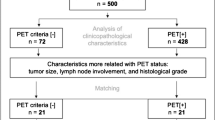Abstract
Purpose
The purpose of the study was to assess the diagnostic performance of positron emission tomography/computed tomography and fluorodeoxyglucose (18F) (FDG PET/CT) for the staging and the follow-up of anal carcinoma, and to evaluate the impact of FDG PET/CT on patient management.
Materials and methods
Patients with anal carcinoma were referred to our department from October 2004 until July 2008. The diagnostic performance was evaluated on a per-examination basis and on a per-site basis, together with impact of PET/CT on patient management. The standard of truth was histology when available and, in all cases, follow-up data during at least 6 months.
Results
Fifty-eight FDG PET/CT performed in 44 patients were analysed—22 for initial staging and 36 during follow-up. The detection rate of non-excised tumours on initial examination was 93%. During post-treatment follow-up, FDG PET/CT had, on a per-examination basis, sensitivity for the detection of persistent or recurrent disease of 93% and specificity of 81%, and on a per-site basis, 86% and 97%, respectively. Its negative predictive value was 94% on a per-examination basis and 98% on a per-site basis. FDG PET/CT had an impact on management in nine patients out of 44 (20%), which was relevant in eight of them (89%).
Conclusion
FDG PET/CT is an accurate imaging modality in anal cancer. It has an interesting added value during post-treatment follow-up, especially when persistence or recurrence of disease is suspected. Further studies are needed to evaluate whether surveillance by means of FDG PET/CT might have a positive impact on overall survival.



Similar content being viewed by others
References
Jemal A, Siegel R, Ward E et al (2008) Cancer statistics, 2008 CA. CA: A Cancer Journal for Clinicians 58:71–96
Johnson LG, Madeleine MM, Newcomer LM et al (2004) Anal cancer incidence and survival: the surveillance, epidemiology, and end results experience, 1973–2000. Cancer 101:281–288
Welton ML, Sharkey FE, Kahlenberg MS (2004) The etiology and epidemiology of anal cancer. Surg Oncol Clin N Am 13:263–275
Fleshner PR, Chalasani S, Chang GJ et al (2008) Practice parameters for anal squamous neoplasms. Dis Colon Rectum 51:2–9
Goldman S, Norming U, Svensson C et al (1991) Transanorectal ultrasonography in the staging of anal epidermoid carcinoma. Int J Colorectal Dis 6:152–157
Scherrer A, Reboul F, Martin D et al (1990) CT of malignant anal canal tumors. Radiographics 10:433–453
Roach SC, Hulse PA, Moulding FJ et al (2005) Magnetic resonance imaging of anal cancer. Clin Radiol 60:1111–1119
Damin DC, Rosito MA, Gus P et al (2003) Sentinel lymph node procedure in patients with epidermoid carcinoma of the anal canal: early experience. Dis Colon Rectum 46:1032–1037
Sato H, Koh PK, Bartolo DC (2005) Management of anal canal cancer. Dis Colon Rectum 48:1301–1315
Gérard JP, Chapet O, Samiei F et al (2001) Management of inguinal lymph node metastases in patients with carcinoma of the anal canal. Cancer 92:77–84
Das P, Bhatia S, Eng C et al (2007) Predictors and patterns of recurrence after definitive chemoradiation for anal cancer. Int J Radiat Oncol Biol Phys 68:794–800
Ghouti L, Houvenaeghel G, Moutardier V et al (2005) Salvage abdominoperineal resection after failure of conservative treatment in anal epidermoid cancer. Dis Colon Rectum 48:16–22
Christensen AF, Nielsen MB, Svendsen LB et al (2006) Three-dimensional anal endosonography may improve detection of recurrent anal cancer. Dis Colon Rectum 49:1527–1532
Shankar LK, Hoffman JM, Bacharach S et al (2006) Consensus recommendations for the use of 18F-FDG PET as an indicator of therapeutic response in patients in National Cancer Institute Trials. J Nucl Med 47:1059–1066
Trautmann TG, Zuger JH (2005) Positron emission tomography for pretreatment staging and posttreatment evaluation in cancer of the anal canal. Mol Imaging Biol 7:309–313
Anderson C, Koshy M, Staley C et al (2007) PET-CT fusion in radiation management of patients with anorectal tumors. Int J Radiat Oncol Biol Phys 69:155–162
Cotter SE, Grigsby PW, Siegel BA et al (2006) FDG-PET/CT in the evaluation of anal carcinoma. Int J Radiat Oncol Biol Phys 65:720–725
Nguyen BT, Joon DL, Khoo V et al (2008) Assessing the impact of FDG-PET in the management of anal cancer. Radiother Oncol 87:376–382
de Winton E, Heriot AG, Ng M et al (2009) The impact of 18-fluorodeoxyglucose positron emission tomography on the staging, management and outcome of anal cancer. Br J Cancer 100:693–700
Schwarz JK, Siegel BA, Dehdashti F et al (2008) Tumor response and survival predicted by post-therapy FDG-PET/CT in anal cancer. Int J Radiat Oncol Biol Phys 71:180–186
Meta J, Seltzer M, Schiepers C et al (2001) Impact of 18F-FDG PET on managing patients with colorectal cancer: the referring physician's perspective. J Nucl Med 42:586–590
Mistrangelo M, Pelosi E, Bellò M et al (2010) Comparison of positron emission tomography scanning and sentinel node biopsy in the detection of inguinal node metastases in patients with anal cancer. Int J Radiat Oncol Biol Phys 77(1):73–78
van Waarde A, Cobben DC, Suurmeijer AJ et al (2004) Selectivity of 18F-FLT and 18F-FDG for differentiating tumor from inflammation in a rodent model. J Nucl Med 45:695–700
Grigsby PW (2009) FDG-PET/CT: new horizons in anal cancer. Gastroentérol Clin Biol 33:456–458
Mai SK, Welzel G, Hermann B et al (2009) Can the radiation dose to CT-enlarged but FDG-PET-negative inguinal lymph nodes in anal cancer be reduced? Strahlenther Onkol 185:254–259
Iagaru A, Kundu R, Jadvar H et al (2009) Evaluation by (18)F-FDG-PET of patients with anal squamous cell carcinoma. Hell J Nucl Med 12:26–28
Acknowledgements
We would like to thank the clinicians who referred the patients and also provided us with valuable follow-up information Drs. Atienza, Bourguignon, Etienney, Meary and Mory, from Groupe Hospitalier Diaconesses Croix Saint-Simon, Drs. Huguet and Pene from Hôpital Tenon. We thank Pr Meignan for his review of the draft.
Author information
Authors and Affiliations
Corresponding author
Rights and permissions
About this article
Cite this article
Vercellino, L., Montravers, F., de Parades, V. et al. Impact of FDG PET/CT in the staging and the follow-up of anal carcinoma. Int J Colorectal Dis 26, 201–210 (2011). https://doi.org/10.1007/s00384-010-1080-9
Accepted:
Published:
Issue Date:
DOI: https://doi.org/10.1007/s00384-010-1080-9




